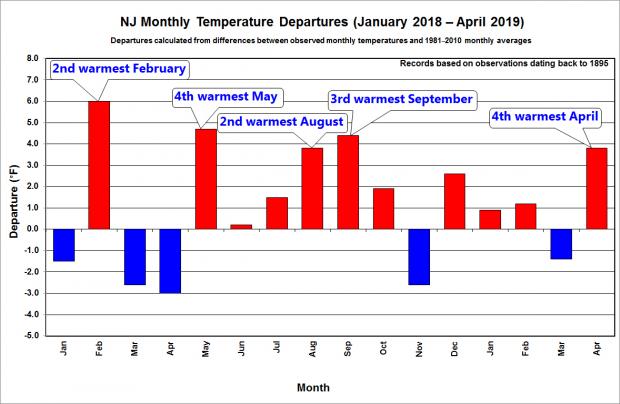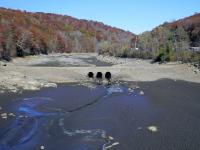So often over the past roughly year and a half, I have been writing about statewide monthly temperatures being among the warmest on record. In fact, February, May, August, and September 2018, as well as April 2019, have ranked as 2nd, 4th, 2nd, 3rd, and 4th warmest, respectively, since statewide averages began being generated in 1895 (see the accompanying figure). Throughout this century, this has so often been the case that, seemingly, it is almost expected each month. Not necessarily a top 5 ranking, but often in the top 20.

This got me wondering whether I was exaggerating the warmth since 2000. Thus an evaluation of rankings was performed for each month and for the year as a whole. This included generating counts of the warmest top 10 and top 20 warmest months since 1895 that have occurred from January 2000 through April 2019. Results are shown in the accompanying table.
Given that the roughly 19 years of this century account for just over 15% of the years since 1895, and assuming all things in the climate system being equal over that time, one should expect one or two 21st-century months or calendar years to rank in the top 10 and three in the top 20 warmest. This has hardly been the case. Ten months have experienced their warmest instance on record since 2000, the only exceptions being January and September. Also, 2012 was the warmest year on record. When considering all months, 47% have occurred since 2000, with seven of the top 10 (70%) warmest calendar years also occurring during the same period. For five months, six of the top 10 warmest have occurred since 2000. Only January and October are near long-term expectations, each with two instances in the top 10.
Thirteen annual averages (65%) since 2000 have been in the top 20 warmest. An average of 7.1 months of the top 20 (36%) have occurred since 2000, with some months having as many as 10 occurrences (April, July, and August). Even with relatively low counts of four instances of top-20 warmth for March (though all four fall within the top eight) and October, these still demonstrate a larger proportion of top-20 warm months since 2000 than would otherwise be expected during any given 19-year period.
| #1 Warmest | # in top 10 | # in top 20 | |
|---|---|---|---|
| January | 1932 | 2 | 5 |
| February | 2017 | 4 | 6 |
| March | 2012 | 4 | 4 |
| April | 2017 | 6 | 10 |
| May | 2015 | 5 | 7 |
| June | 2010 | 4 | 6 |
| July | 1955/1999/2011 | 6 | 10 |
| August | 2016 | 6 | 10 |
| September | 1961 | 6 | 8 |
| October | 2007 | 2 | 4 |
| November | 2015 | 6 | 8 |
| December | 2015 | 5 | 7 |
| Annual | 2012 | 7 | 13 |
Warmest months statewide in New Jersey since 1895. The “#1 warmest” column shows the year of the warmest month and year. The “top 10” and “top 20” columns show counts of the years from January 2000 – April 2019 where temperatures were among the 10 or 20 warmest over the 124/125 years of record.
So it wasn’t my imagination. The first two decades of the 21st century are proving to be far warmer than any such interval in the 20th century, and by a wide margin. It has become quite apparent that this warmth is due to what is commonly referred to as global warming caused by human influences on the atmosphere, oceans, and landscape. Greenhouse theory, a wealth of observations well beyond just those of NJ temperatures, and numerical climate models based on well-accepted physical principles all suggest that a human-induced change signal began to emerge from a naturally variable climate system about 40 years ago. Clearly, we are now seeing this across the Garden State. To gain a greater understanding of our climate system and climate change, I suggest an excellent primer that was produced by the US National Academies of Science and the UK Royal Society.
As for the future, expect to see years and decades that continue to establish new records or near records for warmth. Just how many and how extreme they may be will depend on how and how rapidly humankind addresses the issue of climate change and just how the climate continues responding to the changes we are making to the system.






